
The paintpot cuttlefish is a small, poorly researched species of cuttlefish found in the Indo-Pacific, between Japan and Hong Kong. It is one of the two species classified in the genus Metasepia. Metasepia cuttlefish are characterized by their small, thick, diamond-shaped cuttlebone, and distinctive body coloration.

Doryteuthis opalescens, the opalescent inshore squid or market squid, is a small squid in the family Loliginidae. It is a myopsid squid, which is the near shore group and that means that they have corneas over their eyes. The species lives in the eastern Pacific Ocean from Mexico's Baja California peninsula to Alaska, United States, and as an inshore squid it can be found with a range of 200 miles (320 km) off the coast.
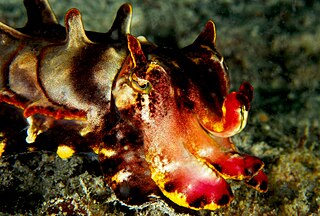
Metasepia pfefferi, also known as the flamboyant cuttlefish, is a species of cuttlefish occurring in tropical Indo-Pacific waters off northern Australia, southern New Guinea, as well as numerous islands of the Philippines, Indonesia and Malaysia. The flesh of this colorful cephalopod contains unique acids, making it unsuitable for consumption.

The common cuttlefish or European common cuttlefish is one of the largest and best-known cuttlefish species. They are a migratory species that spend the summer and spring inshore for spawning and then move to depths of 100 to 200m during autumn and winter. They grow to 49 cm in mantle length (ML) and 4 kg in weight. Animals from subtropical seas are smaller and rarely exceed 30 cm in ML.

Sepia novaehollandiae is a species of cuttlefish native to the southern Indo-Pacific. Its natural range stretches from Shellharbour, New South Wales to North West Shelf in Western Australia. It lives at depths of between 15 and 348 m.
Sepia australis, the southern cuttlefish, is a species of cuttlefish which is found in the eastern South Atlantic Ocean and the western Indian Ocean off the coasts of Southern Africa, possibly extending into the waters off East Africa.
Sepia hedleyi, or Hedley's cuttlefish, is a species of cuttlefish in the family Sepiidae, endemic to subtropical and temperate waters off Australia.
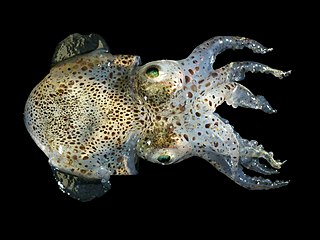
Sepiola atlantica, also known as the Atlantic bobtail, is a species of bobtail squid native to the northeastern Atlantic Ocean and the Mediterranean Sea.
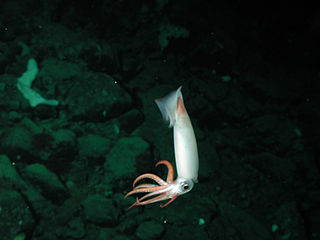
The Gonatus Onyx is in the class Cephalopoda, in the phylum Mollusca. It is also known as the Clawed arm hook squid or Black-eyed squid. It got these names from the characteristic black eye and from its two arms with clawed hooks on the end that extend a bit further than the other arms. It is a squid in the family Gonatidae, found most commonly in the northern Pacific Ocean from Japan to California. They are one of the most abundant cephalopods off the coast of California, mostly found at deeper depths, rising during the day most likely to feed.
Sepia zanzibarica, or the Zanzibar cuttlefish, is a species of cuttlefish native to the Indian Ocean.

Sepia prashadi, common name hooded cuttlefish, is a widely distributed species of cuttlefish. It has a thin, oval body and grows from 5 to 11 cm. The tips of the tentacles have a distinct club shape. S. prashadi is a migratory, demersal cuttlefish living in shallow waters at depths of approximately 40 to 50 metres. It is found in many locations including the east coast of Africa, around India, in the Red Sea, and Persian Gulf.
Sepia braggi, the slender cuttlefish, is a species of cuttlefish native to the Indo-Pacific Ocean. It has been found in coastal waters of southern Australia. This species was first collected in South Australia by its namesake, William Lawrence Bragg. Sepia braggi was then described by Sir Joseph Cooke Verco in 1907.Sepia braggi is part of the subgenus Doratosepion which contains to 41 species of cuttlefish in total.
Sepia bertheloti, the African cuttlefish, is a species of cuttlefish from the family Sepiidae which is found in the warmer waters of the eastern Atlantic Ocean off Africa.

Sepia orbignyana, the pink cuttlefish, is a species of small cuttlefish from the family Sepiidae. It is occurs in the temperate and tropical waters of the eastern Atlantic Ocean.
Sepia hierredda, the giant African cuttlefish, is a species of cuttlefish from the family Sepiidae, which was previously considered conspecific with the common cuttlefish Sepia officinalis. It is found along the western coast of Africa and is an important species to fisheries.

Alloteuthis media, the midsize squid or little squid, is a species of squid in the family Loliginidae from the eastern Atlantic and the Mediterranean Sea. It is generally a by-catch species in trawl fisheries, although there is an active fishery in the western Mediterranean.
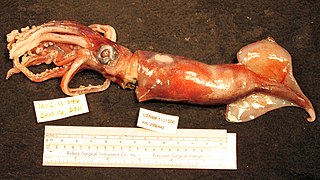
Ornithoteuthis antillarum, the Atlantic bird squid, is a species of flying squid from the family Ommastrephidae which is found in the warmer waters of the Atlantic Ocean. This species is an important component of the diet of many species of fish and of cetaceans. It is taken as a bycatch in fisheries but has the potential to be commercially important if appropriate fishing methods can be developed.
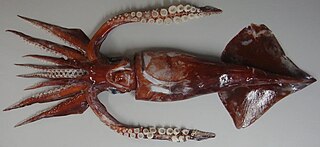
The Antarctic flying squid is a species of squid from the subfamily Todarodinae of the family Ommastrephidae, a family of pelagic squid from the order Oegopsida. It has a circumglobal distribution in the seas around the lower latitudes of the Southern Oceans.

The European flying squid is a species of squid from the continental slope and oceanic waters of the eastern Atlantic Ocean and the Mediterranean Sea. It is the type species of the genus Todarodes, the type genus of the subfamily Todarodinae of the pelagic squid family Ommastrephidae. It is a species which is targeted by some fisheries, although it is more often a bycatch.

Sepia lycidas, commonly known as the kisslip cuttlefish, is a species of cuttlefish within the genus Sepia. They are also classified under the family Sepiidae, which encompasses some of the most commonly known and recognized cuttlefish. Phylogenetically, this species of cuttlefish is most closely related to Sepia aculeata, Sepia esculenta, and Sepia pharaonis. This species is typically reddish brown to purple in color, with patches and stripes present on their dorsal mantle. On average, they grow to be about 38 cm in length and weigh 5 kg at maximum. The kisslip cuttlefish can be found mainly within the Indo-West Pacific, at depths ranging from 15–100 meters. Additionally, this species exhibits many diverse, complex reproductive behaviors; for example, courting, mating displays, and mate competition. Other interesting behaviors includes their feeding and hunting methods, which entails turning towards a preferred direction to "jump on" and engulf their prey of small fish and crustaceans. Sepia lycidas has many human uses and is important in the economy of many Southeast Asian countries, especially since they are often eaten for their high nutritional value. They are also currently being studied as an alternative source of collagen for human use, since their thick outer skin contain high levels of collagen that goes to waste when they are eaten or caught as bycatch.
















